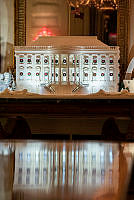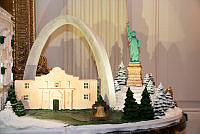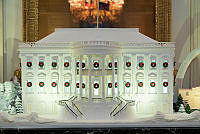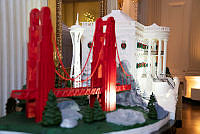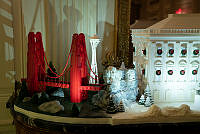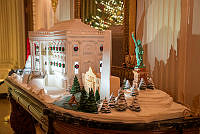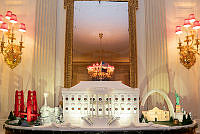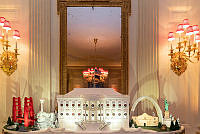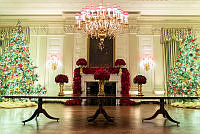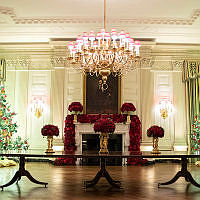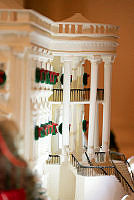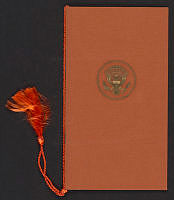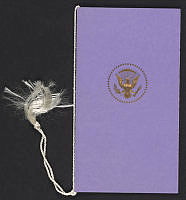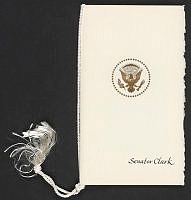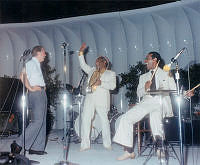America Under Fire: Aftermath

Timeline of Events:
- August 29, 1814: Faced with a British demand to surrender 21 merchant ships, naval and ordinance stores and cotton, flour, tobacco and wines from the city warehouses or face attack from a squadron of seven ships, Alexandria's mayor and council bowed to the inevitable and agreed to the British demand—for they had no reliable defenses or defenders.
- August 30, 1814: A wave of relief swept over Washington as people learned that the British squadron had left Alexandria and sailed away. Fears eased when a force of about 450 District militiamen commanded by General Walter Smith arrived to provide protection to the city.
- August 31, 1814: As news of the capture and burning of Washington spread throughout the country, faith in Madison's leadership reached an all-time low. Around the nation, there were demands that he be impeached and that his Cabinet resign. Graffiti scribbled on one of the Capitol walls read: "George Washington founded this city after a seven years' war with England – James Madison lost it after a two years' war."
- September 4, 1814: To everyone's general relief, Madison accepted General Armstrong's resignation as Secretary of War. Madison promptly replaced Armstrong with James Monroe who radiated purpose. Monroe immediately called up militia to reinforce troop strength around Washington and Baltimore and placed Senator Samuel Smith, leader of the Maryland militia, in command of the defense of Baltimore. He also ordered Andrew Jackson and his militia to head for New Orleans to meet an anticipated British attack.
- September 11-14, 1814: The British planned a two-pronged operation to capture what was by 1814 a bustling seaport and unofficial naval base for privateers. Major General Robert Ross would attack by land at North Point, and Vice Admiral Sir Alexander Cochrane would besiege Fort McHenry in Baltimore harbor. The British landed a force of 5,000 troops and eight cannons at North Point, about 10 miles southeast of Fort McHenry. The U.S. commander, Major General Samuel Smith, selected his best men—the City (3rd) Brigade made up of 3,200 native Baltimoreans under the command of General John Stricker—to confront the British. Baltimore tradition holds that two young sharpshooters from the 5th Maryland Militia rifle company killed Ross when he rode forward to direct his troops. Amid heavy casualties from the assaults, the Americans began to retreat – although a tactical victory for the British, the Marylanders succeeded in delaying an attack on Baltimore.
- Cochrane's squadron of 16 ships opened fire on Fort McHenry's garrison of about 1,000 soldiers with Congreve rockets and mortar shells. Defenders had prepared the harbor defenses well by sinking several merchant ships, obstructing two of the entrances to Baltimore Harbor. The British managed to send about 1,500 to 1,800 cannon balls and shells into the fort, but McHenry withstood the barrage.
- Realizing they risked serious casualties at the hands of well dug-in American defenders, the British land force acknowledged defeat at Baltimore and embarked their troops from North Point. When news reached Washington of the British defeat, the National Intelligencer headlined: "HUZZA FOR BALTIMORE!"
- September 20, 1814: The Baltimore Patriot published Francis Scott Key's 32-line poem, "Defence of Fort McHenry." In the morning after the ferocious enemy bombardment a gigantic (30 feet by 42 feet) American flag flown over Fort McHenry inspired Key to write his poem. The first eight lines are the most familiar:
O say can you see by the dawn's early light,
What so proudly we hailed at the twilight's last gleaming,
Whose broad stripes and bright stars through the perilous fight,
O'er the ramparts we watched, were so gallantly streaming?And the rockets' red glare, the bombs bursting in air,
Gave proof through the night that our flag was still there;
O say does that star-spangled banner yet wave,
O'er the land of the free and the home of the brave? - October 17, 1814: Secretary of War Monroe reported to the Senate Committee on Military Affairs that the nation needed a conscript army of 100,000 men to defend the nation. It had been an article of faith that an untrained citizen-soldier under the supervision of his state—not the federal government—was the worthiest way to defend the republic. The experiences of August 1814 provided a hard lesson that ill-equipped and untrained militiamen could not stand against professional enemy fire.
- October 29, 1814: Public Buildings and Grounds Superintendent [Thomas] Munroe reported to Congress that "the walls of the President's House ... will be safe and sufficient to rebuild on." Munroe estimated the cost of rebuilding the White House at $334,334, compared to $787,163 for both wings of the Capitol and $93,613 for public offices.
- November 16, 1814: President Madison declared January 12, 1815 as "a day of public humiliation and fasting and of prayer to Almighty God for the safety and welfare of these States, His blessing on their arms, and a speedy restoration of peace."
- December 24, 1814: On Christmas Eve, U.S. and British negotiators signed the Treaty of Ghent, ending hostilities, but leaving agreements on free trade and sailors' rights to be decided later. The Prince Regent (later George IV) endorsed the treaty. Anthony St. John Baker, the British secretary at Ghent, and Henry Carroll, Henry Clay's private secretary, left London for the United States on the British sloop of war HMS Favourite with copies of the treaty.
- January 30, 1815: The House of Representatives approved the purchase of former President Jefferson's 6,487-volume library for $23,900 to start rebuilding the collection destroyed in the 1814 fire.
- February 4, 1815: Word reached Washington of Jackson's victory at New Orleans. A crowd of joyful people bearing torches assembled in front of the Octagon, where Dolley Madison placed candles in every window.
- February 13, 1815: News reached Washington that the British Ship HMS Favourite had arrived in New York with a treaty. The Senate passed a bill appropriating $500,000 to rebuild the President's House, Capitol, and public offices “on their present sites,” to be borrowed by the president “from any bank or banks within the district of Columbia, or from any individual or individuals” at an interest rate of six percent.
- February 14, 1815: In the late afternoon Henry Carroll arrived in Washington with a copy of the Treaty of Ghent. Cheering crowds followed his carriage as it picked up Monroe at his house on I Street and continued to the Octagon. While her husband and his cabinet carefully studied the treaty in his office upstairs, the first lady opened the house to members of Congress, government officials and the general public who crowded in, eager to discover exactly what was going on.
- February 16, 1815: Senate ratified the Treaty, 35 to 0. At 11:00 p.m. Madison exchanged ratified copies of a now binding treaty with Anthony St. John Barber, who had arrived from New York.
- February 17, 1815: Madison signed the Treaty of Ghent at the Octagon. At 7:00 p.m., candles and oil lamps throughout the city were brought out for an illumination of all homes.
- March 4, 1817: James Monroe was inaugurated as the Fifth President on an "elevated porch" at the temporary Brick Capitol before a crowd of 8,000—at the time, the largest gathering to attend an inaugural.
- May 31, 1817: President Monroe started on a grand tour of New England and the Midwest to promote national unity, emulating George Washington's grand tour of 1789.
- September 17, 1817: Monroe returned from his grand tour and moved into the White House. The following day, the National Intelligencer noted with approval, "It was with great pleasure we once more beheld the President of the United States entering the dwelling appropriated by the Nation to his use."
- January 1, 1818: On a day of sunlit weather, the White House formally reopened with an impressive New Year's Day reception hosted by the president and First Lady Elizabeth Kortright Monroe.

The Baroness Anne Marguerite Hyde de Neuville's watercolor illustrated the rebuilt White House and executive office buildings, 1821.














